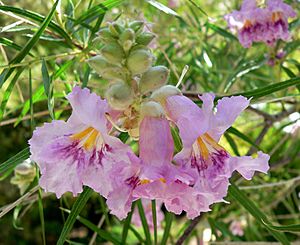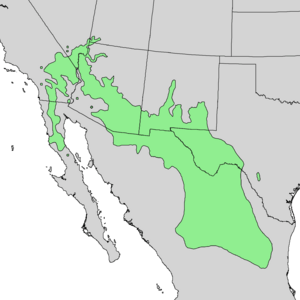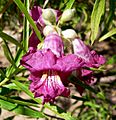Desert willow facts for kids
Quick facts for kids Desert willow |
|
|---|---|
 |
|
| Conservation status | |
| Scientific classification | |
| Genus: |
Chilopsis
|
| Species: |
linearis
|
 |
|
| Natural range of Chilopsis linearis | |
| Synonyms | |
|
Bignonia linearis Cav. |
|
The Desert Willow (scientific name: Chilopsis linearis) is a beautiful flowering plant. It's the only species in its group, called a monotypic genus. People call it "desert willow" because its leaves look like those of a willow tree. But don't be fooled! It's not a real willow. Instead, it belongs to the catalpa family, which includes other well-known trees.
This plant grows as a shrub or a small tree. You can find it naturally in the southwestern United States and Mexico. It often grows in dry riverbeds (called washes) and along the banks of rivers.
Contents
What Does the Desert Willow Look Like?
The Desert Willow can grow from about 5 feet (1.5 meters) to as tall as 26 feet (8 meters). It can be a bushy shrub or a slender small tree. Its leaves are long and thin, like lines. They are also curved and fall off in the autumn, which means they are deciduous. These leaves are usually 4 to 10 inches (10 to 26 cm) long and only a few millimeters wide.
The name Chilopsis comes from two Greek words: cheilos, meaning "lip," and opsis, meaning "resembling." This name describes the shape of its flowers. The flowers grow in clusters at the ends of branches and bloom from May through September. Usually, two to four flowers open at a time in each cluster.
The cup-like part at the base of the flower, called the calyx, is about 0.3 to 0.5 inches (8–14 mm) long. It's slightly puffy and can be different shades of purple. The main part of the flower, the corolla, is 0.8 to 2 inches (2–5 cm) long. Its colors range from light purple to soft pink. The inside of the flower has cool yellow ridges and purple lines. The edges of the petals look crinkled.
Large bees are the main helpers for pollination. These include carpenter bees, bumblebees, and other types of bees. After the flowers are pollinated, a long, thin seed pod grows. This pod can be up to 14 inches (35 cm) long. Inside, it holds many seeds that have tiny wings, helping them fly away in the wind.
There are two main types, or subspecies, of Desert Willow:
- Chilopsis linearis subsp. linearis: Found in Utah, Arizona, New Mexico, western Texas, and Mexico.
- Chilopsis linearis subsp. arcuata: Found in Nevada, California, and Baja California.
Where Does the Desert Willow Grow?
The Desert Willow is a special plant called a phreatophyte. This means it's very good at finding and using water deep in the ground. Because of this, it thrives in dry desert washes and sandy streams that might only have water sometimes.
You can find this plant across much of the southwestern United States and northern Mexico. It usually grows in areas below 5,000 feet (1,500 meters) in elevation.
How People Use Desert Willow
People often grow Desert Willow in their gardens because of its large, colorful flowers. It's also popular because it can handle hot, dry weather very well. Naturally, the plant might grow in an uneven shape. But you can easily trim it to look like a more traditional tree.
Gardeners have also chosen special types of Desert Willow called cultivars. Some of these, like 'Rio Salado', have flowers that are dark purple or magenta. The Desert Willow can survive cold temperatures, even as low as 10 degrees Fahrenheit (-12°C).
The Desert Willow is closely related to the Catalpa tree. They are so similar that they can even create a hybrid plant! This special hybrid, called ×Chitalpa tashkentensis, is a mix of Desert Willow and the Southern Catalpa. It was first created in a botanical garden in Tashkent, Uzbekistan.
In the past, parts of the Desert Willow plant were used in traditional medicine. People used it to help with fungal infections like athlete's foot. It was also used for wounds and to help with coughs. The wood from the Desert Willow was also used to make things like bows and baskets.
Gallery
See also
 In Spanish: Chilopsis para niños
In Spanish: Chilopsis para niños





